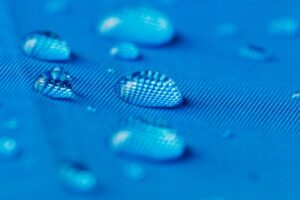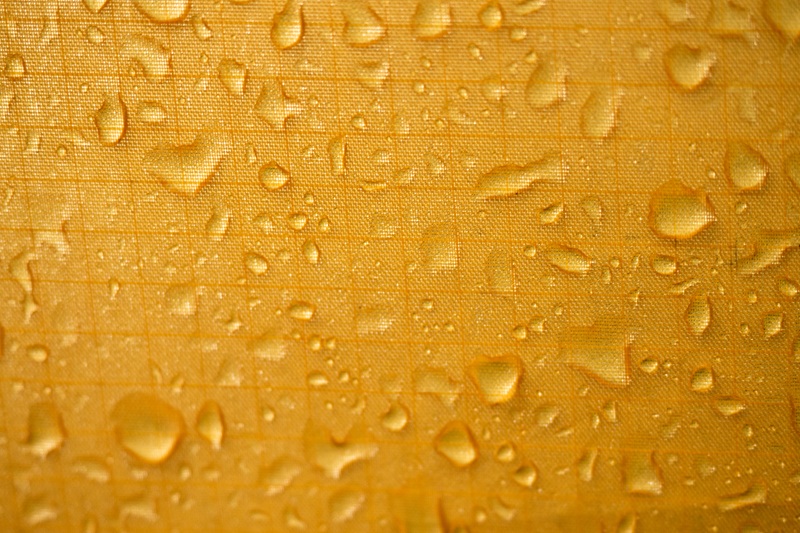Beginner's Guide to Fabrics for Backpacking Gear

Table of Contents
Fabrics Used for Backpacking Gear
Nylon and polyester are the most common fabrics used for backpacks, tents, sleeping bags, and shells.
Most mid- to high-end tents are made of nylon fabric because of its high strength-to-weight ratio and abrasion resistance.
Polyester fabric is typically used for low-end tents because it’s heavy to compensate for its low strength-to-weight ratio.
Dyneema Composite Fabric (DCF), also called Cuben fiber, is used in some high-end tents and backpacks because of its superior water resistance and strength-to-weight ratio. DFC consists of ultra-high-molecular-weight polyethylene (UHMWPE) coated on both sides with polyester. It’s extremely expensive.
Comparison of Polyester, Nylon, and Dyneema Composite Fabric (DCF)
| Cost | Weight | Strength | UV Resistance | Abrasion Resistance | Heat Resistance | Water Resistance | Stretchiness | |
|---|---|---|---|---|---|---|---|---|
| Highest | DCF | Polyester | DCF | Polyester & DCF | Nylon | Polyester | DCF | Nylon |
| Nylon | Nylon | Nylon | Polyester & DCF | Nylon | Polyester | Polyester | ||
| Lowest | Polyester | DCF | Polyester | Nylon | DCF | Nylon | DCF |
Due to its polyester coating, DCF has UV resistance and abrasion resistance similar to those of polyester.
Ripstop Nylon

Ripstop nylon has strong reinforcement fibers interwoven at regular intervals in a crosshatch pattern. It’s highly resistant to tearing.
Fiber Weight and Denier
The heavier the fiber, the greater the strength and abrasion resistance. The most common unit for fiber weight is the denier (D), the weight in grams of 9,000 meters of fiber.9,10,11,17,18
Water-resistant 10-20D ripstop nylon is the most common fabric used for shells.
Most tents are made of 20-40D nylon. Ultralight tents are typically made of 10-20D silicone-impregnated nylon. Many ultralight DCF tents are made of 5-10D DCF.
Backpacks should be made of at least 210D ripstop nylon to prevent abrasion.
Weave Density
Weave density, also called fabric density, is the tightness of a fabric’s weave. It can be expressed in various ways, including thread count and weight per area .10,13,17
Thread count is the number of horizontal and vertical threads per area.14,15,16,17,18 It’s sometimes expressed by the letter “T,” especially for polyester fabrics. “190T polyester” indicates a thread count of 190 threads per square inch.14,15
Weight per area is commonly measured in GSM (grams per square meter, g/m2)17.
Fabrics with high weave density are smooth, soft, warm, durable, abrasion-resistant, and water-resistant. They’re also down-proof—feathers and down quills aren’t lost through their pores.12 However, they’re heavy and not very breathable.
Fabrics made of polyester or low-denier nylon fibers tend to have high weave densities to compensate for the weakness of the fibers. This makes the fabrics heavy.
A Common Misconception about "T"
It’s true that fiber weight is sometimes measured in tex instead of deniers.10 However, the “T” in “190T polyester” indicates thread count, not fiber weight.14,15,17,18 T does not stand for tex. I’ve confirmed this directly by email with a fabric manufacturer21. This misconception appears to have been spread by AI. (This is an example of why I don’t rely on AI when writing content for this website!)
Just remember that D indicates the weight per length of a fiber, while T indicates the number of threads per area of a fabric. D and T can’t be interconverted, because they’re independent of each other.
You don’t need to remember tex because it’s not commonly used for backpacking gear.
Waterproofing Coatings
Fabrics are typically waterproofed with one or more of the following coatings:
- Polyester urethane (PU)
- Silicone
- Polyether urethane (PE)
PU-coated fabrics are inexpensive and are commonly used for rain gear and tents. Although waterproof, they absorb water over time, making them stretchy, saggy, and susceptible to mildew. This is because PU is hydrophilic—it slowly bonds to water while preventing it from passing through.19
Silicone-impregnated fabrics have high tear strength, stretch resistance, and mold resistance, and they don’t absorb water.19 They’re also expensive. Silicone-coated nylon, or silnylon, is typically used in mid- to high-end tents.
PE is rarely used, except in high-denier floors of heavy expedition tents.19
DCF is inherently waterproof and doesn’t need to be coated.
To learn about waterproofing for rain gear, see Learn about Rain Gear for Backpacking.
Pros and Cons of Waterproof Coatings
| Coating | Pros | Cons |
|---|---|---|
| PU | Highly waterproof High tear strength Affordable | Absorbs water over time Stretches when wet over time Susceptible to mold |
| PE | Doesn’t absorb water Doesn’t stretch when wet Highly resistant to mold | Low tear strength Uncommon More expensive than PU |
| Silicone | High tear strength Doesn’t absorb water Doesn’t stretch when wet Highly resistant to mold | More expensive than PU |
References
21. Ninbo MH. Personal communication, August 19, 2025
22. Ninbo MH. Personal communication, August 18, 2025
